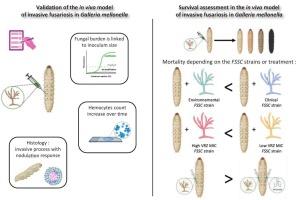In vivo Fusarium virulence and efficacy of voriconazole in a Galleria mellonella model of invasive fusariosis
IF 1.9
4区 生物学
Q4 BIOCHEMICAL RESEARCH METHODS
引用次数: 0
Abstract
Fusarium species are transkingdom pathogens involved in invasive fungal infections in immunocompromised patients. Despite high minimum inhibitory concentrations (MICs), voriconazole (VRZ) is the antifungal recommended as a first-line treatment for this infection.
The objective of this study was to use larvae of the invertebrate Galleria mellonella to describe invasive Fusarium infection, evaluate the virulence profiles of a set of strains and determine the response of Fusarium to antifungal treatment.
After characterization of the fungal infection in G. mellonella threw histological analysis, fungal burden by qPCR and hemocyte counts, larval survival was evaluated after injection of Fusarium solani species complex (FSSC) conidia, with or without therapeutic VRZ injection.
In the described model, an increase in fungal burden was observed in relation to the inoculum size and duration of infection, which was associated with an increase in hemocyte counts. Histopathological examination revealed the invasive nature of the filamentous fungus, along with a nodulation process at the highest inoculum concentrations. Mortality and consequently virulence varied according to the strains under investigation. However, a subgroup analysis by VRZ MIC and strain origin revealed slightly increased mortality for the strains most susceptible to VRZ, as well as for the strains of clinical origin in infected larvae. In this model, VRZ presented in vivo activity and post-infection treatment decreased larval mortality.
The originality of this study lies in the integrated use of the invertebrate model G. mellonella, which is not employed solely for survival analysis, but comprehensively as an in vivo model of invasive fungal infection, with infection monitoring performed through multiple technical approaches.

伏立康唑对侵入性镰孢菌模型体内镰孢毒力和疗效的影响。
镰刀菌属是涉及免疫功能低下患者侵袭性真菌感染的跨界病原体。尽管最低抑菌浓度(mic)较高,伏立康唑(VRZ)仍被推荐作为这种感染的一线治疗药物。本研究的目的是利用无脊椎动物mellonella Galleria的幼虫来描述侵袭性镰刀菌感染,评估一组菌株的毒力谱,并确定镰刀菌对抗真菌治疗的反应。采用组织学分析、qPCR检测真菌负荷、血细胞计数等方法对茄枯菌菌种复合体(Fusarium solani species complex, FSSC)分生孢子进行真菌侵染鉴定,并对注射或不注射治疗性VRZ后的幼虫存活率进行评估。在所描述的模型中,真菌负荷的增加与接种量和感染持续时间有关,这与血细胞计数的增加有关。组织病理学检查显示丝状真菌的侵袭性,在最高接种浓度下伴有结瘤过程。死亡率和因此产生的毒力因所调查的菌株而异。然而,根据VRZ MIC和菌株来源进行的亚群分析显示,对VRZ最敏感的菌株以及临床来源的菌株在感染幼虫中的死亡率略有增加。在该模型中,VRZ具有体内活性,感染后处理降低了幼虫死亡率。本研究的创新之处在于综合利用无脊椎动物模型G. mellonella,该模型不仅仅用于生存分析,而是全面作为侵袭性真菌感染的体内模型,通过多种技术手段进行感染监测。
本文章由计算机程序翻译,如有差异,请以英文原文为准。
求助全文
约1分钟内获得全文
求助全文
来源期刊

Journal of microbiological methods
生物-生化研究方法
CiteScore
4.30
自引率
4.50%
发文量
151
审稿时长
29 days
期刊介绍:
The Journal of Microbiological Methods publishes scholarly and original articles, notes and review articles. These articles must include novel and/or state-of-the-art methods, or significant improvements to existing methods. Novel and innovative applications of current methods that are validated and useful will also be published. JMM strives for scholarship, innovation and excellence. This demands scientific rigour, the best available methods and technologies, correctly replicated experiments/tests, the inclusion of proper controls, calibrations, and the correct statistical analysis. The presentation of the data must support the interpretation of the method/approach.
All aspects of microbiology are covered, except virology. These include agricultural microbiology, applied and environmental microbiology, bioassays, bioinformatics, biotechnology, biochemical microbiology, clinical microbiology, diagnostics, food monitoring and quality control microbiology, microbial genetics and genomics, geomicrobiology, microbiome methods regardless of habitat, high through-put sequencing methods and analysis, microbial pathogenesis and host responses, metabolomics, metagenomics, metaproteomics, microbial ecology and diversity, microbial physiology, microbial ultra-structure, microscopic and imaging methods, molecular microbiology, mycology, novel mathematical microbiology and modelling, parasitology, plant-microbe interactions, protein markers/profiles, proteomics, pyrosequencing, public health microbiology, radioisotopes applied to microbiology, robotics applied to microbiological methods,rumen microbiology, microbiological methods for space missions and extreme environments, sampling methods and samplers, soil and sediment microbiology, transcriptomics, veterinary microbiology, sero-diagnostics and typing/identification.
 求助内容:
求助内容: 应助结果提醒方式:
应助结果提醒方式:


